
Bristol Temple Meads is the oldest and largest railway station in Bristol, England. It is an important transport hub for public transport in the city. In addition to the train services there are bus services to many parts of the city and surrounding districts, and a ferry to the city centre. Bristol's other major station, Bristol Parkway, is a more recent station on the northern outskirts of the conurbation.

The Great Central Railway (GCR) is a heritage railway in Leicestershire, named after the company that originally built this stretch of railway. It runs for 8.25 miles (13.28 km) between the town of Loughborough and a new terminus in the north of Leicester. It has period signalling, locomotives and rolling stock.
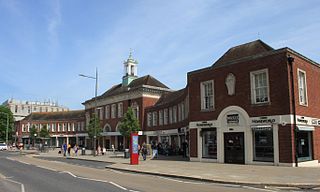
Exeter Central railway station is the most central of the stations in the city of Exeter, Devon, United Kingdom. It is 171 miles 30 chains (275.8 km) down the line from London Waterloo. The station is smaller than Exeter St Davids on the west side of the city.

Crediton railway station is a railway station serving the town of Crediton in Devon, England.
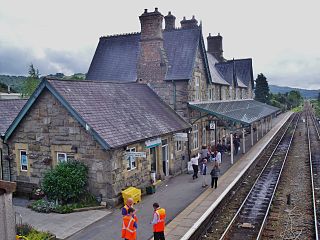
Machynlleth railway station is a railway station on the Cambrian Line in mid-Wales, serving the town of Machynlleth. It was built by the Newtown and Machynlleth Railway (N&MR), and subsequently passed into the ownership of the Cambrian Railways, the Great Western Railway, Western Region of British Railways and London Midland Region of British Railways. It is notable that there is a distance of 22 miles (35 km) between this station and Caersws, the longest distance between two intermediate stations in Wales.
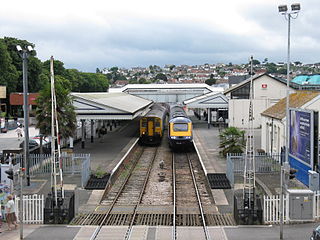
Paignton railway station serves the town and seaside resort of Paignton in Devon, England. It is 222 miles 12 chains measured from London Paddington. The station is the current terminus of the Riviera Line from Exeter and is also an interchange station between National Rail services and the preserved Dartmouth Steam Railway.

Hamilton railway station is a heritage-listed railway station on the Newcastle line in the inner Newcastle suburb of Hamilton in New South Wales, Australia. It was added to the New South Wales State Heritage Register on 2 April 1999.

Torquay railway station is on the Riviera Line and serves the seaside resort of Torquay, Devon, England. It is 219 miles 79 chains measured from London Paddington.

Churston railway station is on the Dartmouth Steam Railway, a heritage railway in Torbay, Devon, England. It is situated beside the main road to Brixham and close to the villages of Churston Ferrers and Galmpton.

Wangaratta railway station is located on the North East line in Victoria, Australia. It serves the town of Wangaratta, and it opened on 28 October 1873.

Bishops Lydeard railway station is a heritage railway station in the village of Bishops Lydeard, Somerset, England. It is the southern terminus for regular trains on the West Somerset Railway.
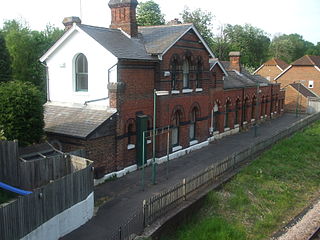
Groombridge railway station is a station on the Spa Valley Railway (SVR) in Groombridge, East Sussex, England. Once a busy station serving four directions, it closed in 1985 to British Rail services. A new station the other side of Station Road bridge was opened by the SVR in 1997 as part of a standard gauge heritage railway to Tunbridge Wells West.
There are 22 disused railway stations in the 75 miles (121 km) between Bristol Temple Meads and Exeter St Davids, 12 of which have structures that can still be seen from passing trains. Most were closed in the 1960s but four of them, especially around Weston-super-Mare, were replaced by stations on new sites. 13 stations remain open on the line today, but there have been proposals to reopen stations at Cullompton and Wellington.
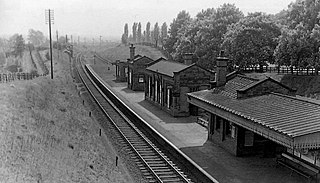
Belgrave and Birstall railway station was a railway station opened by the Great Central Railway in 1899. It served the villages of Belgrave and Birstall in Leicestershire. It closed in 1963.
Swithland Sidings is a set of railway sidings on the preserved Great Central Railway, situated just south of Swithland Reservoir and Swithland Viaduct which crosses it.
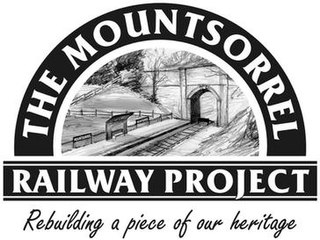
The Mountsorrel Railway was a network of industrial railway lines that served the granite quarries which dominate the Leicestershire village of Mountsorrel. After being closed in the 1950s, a section was reopened in 2015 as a heritage line run by Mountsorrel & Rothley Community Heritage Centre.
Gotham Sidings, was a set of railway sidings on the Great Central Main Line, where the line crosses Gotham Moor near Gotham, Nottinghamshire. The sidings were set between Rushcliffe Halt and Ruddington railway station.

Wootton Bassett Junction railway station, formerly Wootton Bassett railway station, was a junction station in Wootton Bassett where the Great Western and South Wales Main Lines diverge. Opened in 1841, it closed in 1965.
The Nottingham Heritage Railway is a heritage railway and transport museum on the south side of the village of Ruddington in Nottinghamshire. The route consists of almost 10 miles (16 km) of the former Great Central Railway Main Line from Loughborough South Junction to Fifty Steps Bridge and the site of Ruddington's former GCR station, plus a branch line from Fifty Steps Bridge to Ruddington Fields station which is located on a former Ministry of Defence site next to Rushcliffe Country Park.
Swithland was a railway station which was constructed on the Great Central Main Line between Rothley and Quorn and Woodhouse. The station was due to open in March 1899 but was never completed although the line opened as planned in March 1899. The line through the station site was closed in May 1969. The line through the station was reopened in 1990 as the Great Central Railway.















